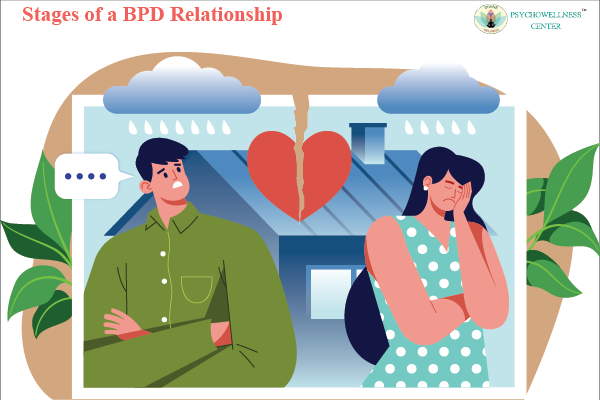For those who have borderline personality disorder (BPD), relationships can be cyclical, passionate, and conflict-ridden. BPD sufferers frequently have intense abandonment fears, but they can also develop phobias of intimacy and proximity. As a result, there is a push-pull between wanting others to pay attention and distancing from them.
A recurrent, continuous sequence of highs and lows in a relationship with a person who has borderline personality disorder is referred to as a BPD relationship cycle. First of all, everything is positive, comforting, and safe; they may regard you as their favorite person. Chaos, rising negative emotions, and severe fury can all happen in the blink of an eye.
Having a sexual or platonic interaction with someone who has been diagnosed with BPD would almost always result in this kind of cycle, which can be shocking.
BPD cycles in romantic relationships sometimes feel dysfunctional due to the possibility of confrontation. It’s crucial to remember that individuals with BPD can also be loving and sympathetic. They have admirable traits, but they also struggle with strong insecurities and worries, which can be challenging to deal with, especially in first-date situations.
People with BPD frequently feel intense anxiety about their spouse leaving them, which makes them susceptible to interpreting unconnected cues as “evidence” that their partner has lost interest. Typically, when this occurs, they withdraw right away or even end the relationship themselves, beginning a back-and-forth cycle that can turn obsessive.
When seeking the Best Psychologist in Delhi, it is crucial to find an expert who not only understands various psychological conditions but also specializes in providing support for individuals dealing with Borderline Personality Disorder (BPD).
Because it depends on a wide range of variables, including the intensity of BPD symptoms, level of functioning, and level of insight of the BPD individual, among many others, the length of a BPD cycle in a romantic relationship can vary substantially. BPD cycles, on the other hand, typically cease as swiftly as they begin. If a relationship exhibits this pattern, it may continue indefinitely with steady intervals in between or it may end in a permanent breakup. Therefore, when searching for a Psychologist near me, consider one with expertise in BPD to ensure comprehensive support for individuals and couples facing these specific challenges.
A borderline personality disorder relationship cycle can typically be broken down into six stages of development.
The six phases of a relationship with borderline personality disorder are as follows:
1. Events Happen Quickly
A new relationship starts, and while it seems promising, it’s frequently seen as progressing swiftly as well. However, it appears that both parties share a desire to create a future together. Based on a few dates, one partner—typically the one with BPD—imagines the relationship to be wonderful. They might start to become fixated on the connection with this individual.
2. Partner with BPD to become more sensitive
As their partner develops BPD, the BPD partner becomes more and more sensitive to everything they say or do. Negative impressions lead to concerns about abandonment and low self-worth. The BPD partner starts to convince themselves that their partner doesn’t care about them.
3. BPD partner manipulates for affection
The BPD partner creates an environment in the Relationship that forces the other person to show their love. By encouraging or coercing the other person to display affection, they hope to feel worthy and to end uneasiness.
4. BPD Partner Becomes Inconsistent
Friction and disagreement result from instability and inconsistent behavior. There could be more problems, which would make the same fear return stronger. Although the spouse without BPD may seem content and contented at this point, it is doubtful that their needs will be addressed. The wedge gets widened as a result.
5. Non-BPD Partner Leaves
At this stage, the non-BPD partner typically ends the union. While the partner without BPD is emotionally unresponsive, the BPD partner could make an effort to justify what happened.
6. Strong Mood Swings
The spouse with BPD could feel down and furious and start to have wild mood swings. They subscribe to their negative inner dialogue, which tells them they are worthless. People who experience acute emotional instability may act irrationally in ways that put their lives in danger or even consider suicide.
For those who have BPD or care about someone who has it, therapy, such as cognitive behavioral therapy (CBT) or dialectical behavior therapy (DBT), can be very helpful. DBT is a well-liked method of treating BPD. This method makes it easier to pinpoint particular emotional problems and consider them from many angles. Medication for borderline personality disorder, together with counseling, can support people when symptoms worsen. For more, you can search Best psychologist in India or take Online counselling, which is easily accessible.
BPD relationship cycles can be debilitating and challenging to control. Your lover could appear to be distant from you at times. Sometimes it may seem impossible to communicate with them. Although maintaining a BPD relationship can be challenging, the cycle can be interrupted with the correct tools and a therapist’s assistance.
Contribution: Dr (Prof) R K Suri, Clinical Psychologist, life coach & mentor TalktoAngel & Aditi Bhardwaj Psychologist

